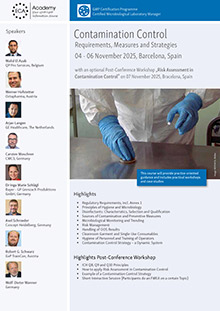Microbiological Updates of the Pharmacopoeias

Recommendation
4-7 November 2025
Barcelona, Spain
Status Update
Currently, a whole series of pharmacopoeia chapters relevant to microbiological quality control are being revised. This affects the European Pharmacopoeia, for example, with chapters 2.6.14 “Bacterial Endotoxins” , 2.7.38 “Bacteriophage Potency Determination”, 5.1.6.”Alternative Microbiological Methods and 5.1.13 Pyrogenicity.
However, in other regions such as the USA, China and Japan, the increasing importance of alternative methods, the reduction of animal testing and the further development of new therapies, such as the use of bacteriophages, are also making it necessary to adapt the regulations.
Alternative microbiological methods in particular offer various possibilities for replacing traditional microbiological methods, firstly because they are faster, which is important for products with a short shelf life, for example, and secondly because the faster results enable corrective measures to be taken at an earlier stage. These possibilities are, of course, also recognised in the regulatory environment, and the staff and expert groups of various pharmacopoeias such as Ph. Eur., USP, ChP and JP are addressing this issue. However, in Europe in particular, the possibilities of Ph. Eur. are also subject to restrictions. As Solène Le Maux explained at the ECA's European Microbiology Conference in Vienna in May, the European Pharmacopoeia cannot provide detailed method descriptions for alternative microbiological methods because they are device-dependent, no monopoly can be supported, or the new alternative methods have not yet been accepted by the regulatory authorities. However, there is a commitment to facilitate the use of rapid microbiological methods. An important step in this direction was the publication of the general chapter 5.1.6 ‘Alternative methods for microbiological quality control’ in 2006, which is currently being revised and was published in Pharmeuropa 37.2 for public comment.
Outlook
It remains to be seen what changes will result from the comments on the Ph.Eur. chapters. Discussions within the ECA's Pharmaceutical Microbiology Working Group show that there is still a need for clarification or supplementation in some areas. This concerns various sections of 5.1.6., whether it be the use of NAT (nucleic acid amplification techniques), the evaluation of ‘stressed microorganisms’ or the question of whether identification methods belong in this chapter or in a separate chapter.
In the area of endotoxins, the question of harmonisation with USP <86> arose, and in Chapter 5.1.13. Pyrogenicity, there was discussion about whether the recombinant cascade reagent needs to be mentioned and how best to deal with potential contamination with non-endotoxin pyrogens.
Get familiar with practical aspects
The ECA course Modern Microbiological Laboratory from 23-25 September 2025 in Barcelona, Spain, will deal with both classical and modern methods. It will not only present the current regulations, but also possibilities and approaches for implementing them in practice. Case studies will be discussed in lectures and interactive workshops in small groups – and your issues can also be discussed. A team of microbiologists – with experience in industrial laboratories, in expert groups of the pharmacopoeia, the ECA Microbiology Working Group and other committees – is available for this purpose.




